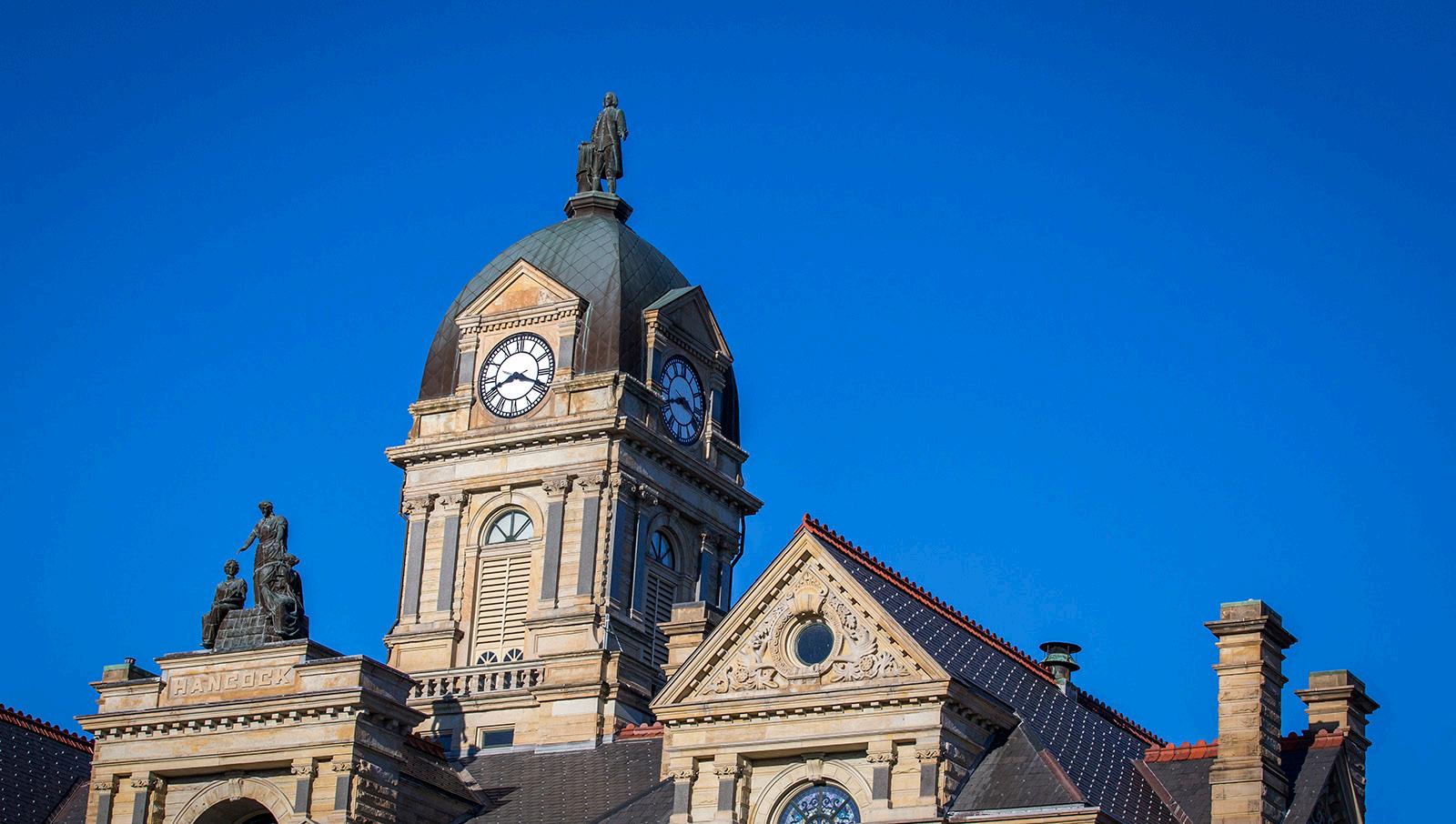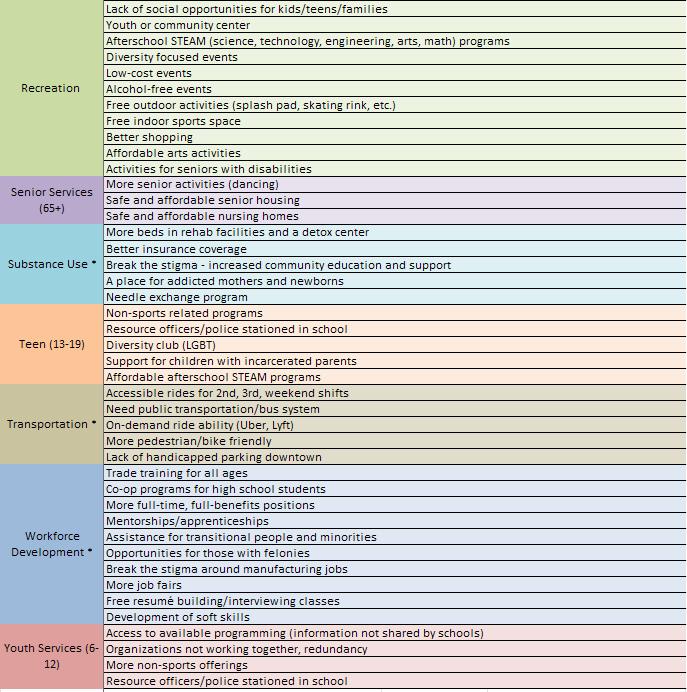
Introduction
In Fall 2016, The Findlay-Hancock County Community Foundation (TCF) and United Way of Hancock County (UWHC) agreed to partner to ask those we serve - those who live, work, learn or play in Hancock County - about their hopes and aspirations for the community. Both organizations had previously conducted community outreach efforts, but the decision to bring resources together created a more efficient and effective process. We undertook this initiative with two goals in mind:
• to validate the current alignment of grantmaking with the needs and priorities of community members and
• to identify gaps in response to the community’s expressed needs.
We owe a debt of gratitude to each person who took the time from work, school and other activities to be a part of this project. Without you, we would not have the valuable data or a plan of action to make change. Thank you all!
Process
In previous outreach endeavors, a full cross-section of our community was not engaged in the process. Both organizations committed to reaching underheard voices in addition to those who usually weigh in. TCF and UWHC worked together to talk to service recipients, in addition to service providers, to get direct feedback and more representative data.
We heard from 1,058 people: 602 people participated in conversations and an additional 456 people provided feedback by written survey. We gained new perspectives through engagement with such groups as: University of Findlay international students; Century Health clients; Children’s Mentoring Connection youth; Hancock County jail inmates; Marathon Petroleum Corporation’s diversity and inclusion team; staff and board of the Black Heritage Library and Multicultural Center; National Alliance on Mental Illness (NAMI) youth; drug court participants; and Jacobs Primary School Leader in Me students.
“Don’t be too proud. No one should be afraid to ask for help from their neighbors.”
Anonymous Conversation Participant
Results
More than 20 community members facilitated 70 conversations all across Hancock County. At the end of each conversation, the results were reported to the University of Findlay, whose students were guided by staff in aggregating the data. The following is a breakdown of each question and the responses, which have been categorized and alphabetized. The results were then boiled down to five major themes of concern:
1. What kind of community do you want?
• Accessible food
• Affordable and available transportation
• Affordable social activities for all
• Affordable, available child care
• Clean
• Diverse/accepting/inclusive
• Drug free
• Good paying jobs
• Healthy
• Holistic approach to care
• Less crime
• Mental health help
• Safe
• Safe, affordable housing
• Strong and safe schools (with special needs resources)
• Sustainable/green
2. What are two or three things you think are standing in the way of the kind of community you want?
• Availabile detox center and recovery home
• Crime
• Drug issues
• Educate/communicate about what is happening/where to get help
• Government bias (cater to businesses or groups of people)
• Homelessness
• Lack of diversity/racism
• Lack of safe, low-cost transportation
• Lack of safe, low-cost housing
• Lack of social opportunities for teens, kids, families, and young people
• Medical costs
• Resources for handicapped and hearing impaired
• Services for abused kids and kids of addicts
• Zoning issues
3. How do these issues affect you personally?
• Access for handicapped persons
• Addiction/ Substance abuse
• Bullying
• Lack of childcare
• Crime
• Domestic violence
• Food
• High recidivism
• Housing
• Lack of family unit (including kids raised by family members/grandparents)
• Living wage
• Mental health
• Preschool
• Transportation
4. What do you think it means to have a good life?
• Access to resources
• Feel safe
• Good health
• Good relationships (friends, family, neighbors)
• Have enough food
• Living wages
• Safe housing
• Structure/stability
• Things to do for kids and families
5. What kind of community would you need for everyone to have the chance at a good life?
• Access to resources, increased support
• Education (trade school, work skills, life skills, financial literacy)
• Good jobs
• Less crime
• Low-cost, available transportation
• Open to diversity (more tolerance)
• Programs in schools (Bridges Out of Poverty, Quest, Leader in Me, DARE+,etc.)
• Safe
• Social opportunities for all (free or low cost)
• Treatment of addiction
6. What kinds of things are keeping us from having this kind of community?
• Affordable housing
• Accessible childcare/preschool
• Affordable school experiences (sports, music, art)
• Drug testing for services
• Flood issues
• Head in the sand (not happening here)
• Help with addiction
• Lack of community (busy, don’t care, not in my backyard mentality)
• Lack of mental health resources
• Livable wages
• Rural/county areas are forgotten
• Too judgmental toward those who are different
• Transportation available 24/7/365
7. What services should be added in our community to help people?
• Addiction/Substance abuse help
• Affordable childcare
• Affordable housing
• Elder care/services
• Food
• Health clinic
• Job/Career training
• Life skills
• Literacy
• Mental health
• More arts and culture
• Safe haven for kids, men’s shelter
• Transportation
8. What do you think can be done to make a difference?
• Affordable preschool
• Break the generational entitlement
• Educate about different cultures, orientations, identities, etc.
• Education about drug use, mental illness
• Foster/mentoring (parents, family, kids)
• Help for people on cliff
• Help Jacobs School (needs more resources)
• Public transportation
• Social activities for young people, kids
• Talk to people who are impacted
• Teach how to write grants
9. Who do you trust to take action on these issues?
• Agencies who assist those in need
• Businesses
• Churches
• City/County
• Groups working together to accomplish things
• Not government
• Police
• Schools
• The Community Foundation
• University of Findlay
• United Way of Hancock County
Considerations/Limitations
The results listed above are a snapshot of a point in time in Hancock County. All of the data was collected over the summer of 2017. We recognize that needs may change seasonally and depending on the happenings in the community at the time of data collection.
Our goal was to hear from 1,000 Hancock County residents. We reached our goal, but were not able to hear from as many people in-person as we hoped. As we revisit the Community Conversations process in the coming years, we hope more people will add their voices to the conversation.
We were successful in hearing from a representational group when compared to the county’s race/ ethnicity, marital status, and most age/income levels. In the future, we need to take additional steps to reach individuals age 12 and under, males, those without a college education, and individuals who earn below $25,000/year.
As we shared in the conversations, not knowing if a service or program exists is the same as it not existing at all. The data is presented as it was heard from the community, even though we understand some of the items mentioned are already being addressed.


